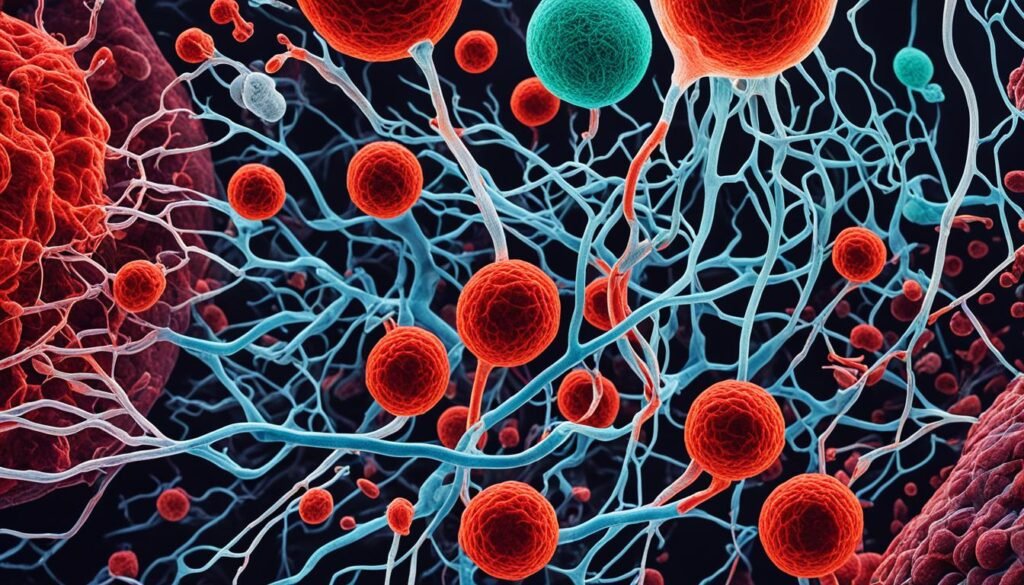Emily In Paris Actress Ashley Park : Ashley Park, the talented actress known for her role in the popular television series “Emily in Paris,” recently shared a harrowing experience with her fans. At the start of the new year, Park faced a major health scare that landed her in the hospital. What began as a battle with tonsillitis quickly escalated into a critical condition called septic shock.
Septic shock is a life-threatening condition that occurs when the body’s response to an infection becomes imbalanced, leading to organ failure. In Park’s case, the infection from her tonsillitis spread rapidly, infecting several of her organs and putting her life at risk. It is a time-sensitive condition that requires immediate medical intervention to prevent further complications.
Thankfully, Ashley Park is now in the process of recovery and feeling grateful for the progress she has made. Her journey through septic shock serves as a reminder of the importance of timely medical treatment and the support of loved ones during challenging times.
Key Takeaways:
- Ashley Park, known for her role in “Emily in Paris,” recently recovered from septic shock.
- Septic shock is a life-threatening condition that occurs when the body’s response to infection becomes imbalanced.
- Immediate medical intervention is crucial in treating septic shock and preventing further complications.
- Ashley Park is grateful for the progress she has made and is determined to continue her journey toward full recovery.
- The support of loved ones and the entertainment industry has been vital in Ashley Park’s healing process.
Ashley Park’s Health Scare and Hospitalization
While on vacation in December, Ashley Park fell ill with tonsillitis. Unfortunately, her condition worsened, and she ended up in the hospital with critical septic shock. This required her to spend time in the ICU and several hospitals, experiencing severe pain. Park expressed her gratitude towards the medical staff who treated her and her boyfriend, Paul Forman, who stood by her side throughout the ordeal.
During her hospitalization, Ashley Park faced numerous challenges and underwent intensive medical care to combat the life-threatening condition. She expressed her appreciation for the dedicated healthcare professionals who tirelessly worked to save her life and provide the necessary treatment. Park’s gratitude extended to her boyfriend, Paul Forman, for his unwavering support and presence during her hospital stay, offering comfort and strength.
“I’m grateful for the incredible medical team who fought alongside me and to my love @formylove for holding my hand (literally) every step of the way. This was the hardest time I’ve ever faced, and I am learning so much from this gift of time.”
Ashley Park’s health scare and hospitalization highlighted the seriousness of septic shock and the critical need for timely medical intervention. Through her experience, she has inspired others with her resilience and strength. Park’s journey serves as a reminder of the importance of gratitude and the power of support in overcoming challenging situations.
Understanding Septic Shock
Septic shock, the most severe form of sepsis, is a critical condition that arises when the body’s response to an infection becomes imbalanced, leading to the potential failure of essential organs. In the case of Ashley Park, the infection originating from tonsillitis spread throughout her body, causing septic shock and adversely affecting multiple organs. Timely medical treatment is of utmost importance for individuals with septic shock, as any delay can significantly increase the risk of complications, including death.
Sepsis, the precursor to septic shock, occurs when the immune system’s response to an infection becomes dysregulated, resulting in widespread inflammation. If not promptly addressed, this can culminate in septic shock, characterized by severe blood pressure drop and impaired organ function. The condition can prove fatal if left untreated.
During septic shock, the infection spreads through the bloodstream, endangering vital organs such as the heart, lungs, liver, and kidneys. The systemic inflammatory response triggered by the infection can disrupt the normal functioning of these organs, contributing to organ failure. The consequences of septic shock can be long-lasting and may require extensive medical intervention and rehabilitation to recover fully.
It is crucial to recognize the signs and symptoms of septic shock promptly. While the specific manifestations can vary, they often involve fever, rapid heart rate, altered mental state, extreme fatigue, and low blood pressure. If an infection is suspected, particularly one that may have penetrated the bloodstream, individuals should seek medical attention immediately.
“Septic shock is a life-threatening condition that demands urgent medical intervention. Delays in treatment can lead to devastating consequences, including organ failure and potential loss of life. It highlights the critical importance of early recognition and prompt medical care for individuals at risk.”
| Key Points | Details |
|---|---|
| Definition | Septic shock is the most severe form of sepsis, characterized by a dysregulated immune response to infection, leading to organ failure. |
| Cause | Septic shock occurs when an infection spreads throughout the bloodstream, affecting multiple organs. |
| Consequences | Septic shock can result in organ failure and, in severe cases, may lead to death. Rehabilitation may be required to fully recover from its effects. |
| Importance of Prompt Treatment | Timely medical intervention is critical in septic shock cases to minimize the risk of complications and optimize the chances of recovery. |
Recognizing the signs and symptoms of septic shock, seeking immediate medical attention, and receiving appropriate treatment are essential for a positive prognosis. As in the case of Ashley Park, early intervention and ongoing medical care play a vital role in the recovery process, helping individuals regain their health and rebuild their lives.
Stay tuned for the next section, where we delve into the importance of timely medical treatment in septic shock cases.
The Importance of Timely Medical Treatment

Sepsis and septic shock are time-sensitive conditions that require early medical intervention to improve patient outcomes. Delayed treatment can have fatal consequences due to the lack of blood flow and widespread inflammation associated with septic shock.
When septic shock occurs, the body’s response to infection can lead to organ failure. The longer a patient with septic shock goes without treatment, the higher the risk of irreversible damage and fatal outcomes. According to statistics, between 15% to 30% of sepsis patients die each year in the U.S. due to septic shock.
Timely medical treatment is essential to prevent the progression of septic shock and its life-threatening complications. By addressing the infection promptly, healthcare professionals can restore adequate blood flow to the organs and mitigate potential damage. The early administration of antibiotics and supportive therapies plays a crucial role in improving patient survival rates.
Effects of Delayed Treatment
The consequences of delayed treatment for septic shock can be severe and potentially irreversible. Without prompt medical intervention, the lack of blood flow to vital organs can lead to:
- Organ failure
- Tissue damage
- Multi-organ dysfunction
- Death
Hence, recognizing the signs and symptoms of septic shock and seeking immediate medical attention is imperative for a favorable prognosis.
“Timely intervention is crucial in septic shock cases. The longer the delay in initiating treatment, the higher the risk of fatal outcomes. Every minute counts in saving lives.” – Dr. Sarah Thompson, Critical Care Specialist
| Consequences of Untreated Septic Shock | Risk Factors | Preventive Measures |
|---|---|---|
| Increased mortality rate | Weakened immune system | Proper wound care |
| Organ failure | Chronic illnesses | Vaccination |
| Long-term complications | Advanced age | Prompt treatment of infections |
Symptoms and Complications of Sepsis

Sepsis is a serious condition that can have devastating effects on the body. Recognizing the symptoms early on is crucial for timely intervention and treatment. Common symptoms of sepsis include:
- Shivering: Uncontrollable shaking or chills may indicate an infection or systemic response.
- Extreme Pain: Intense and persistent pain that may be localized or widespread throughout the body.
- Disorientation: Confusion, altered mental function, or difficulty focusing.
- Shortness of Breath: Difficulty breathing or rapid, shallow breathing.
Sepsis can occur as a result of various infections, including those affecting the lungs, urinary tract, gut, and skin. If untreated, sepsis can lead to life-threatening complications and long-term consequences.
Long-term Complications
In severe cases of sepsis, where the infection has caused significant damage to organs, individuals may experience long-term complications. These complications can vary depending on the affected organs and may include:
- Organ dysfunction or failure
- Loss of limb or extremity
- Psychological and cognitive impairments
- Chronic pain
- Post-sepsis syndrome, involving symptoms such as fatigue, muscle weakness, and difficulty sleeping
Recovery from sepsis and its complications can be a lengthy and challenging process, requiring ongoing medical care and support.
Ashley Park’s Gratitude and Promise of Healing

Ashley Park, known for her role in the popular television series “Emily in Paris,” recently shared an emotional Instagram post expressing her gratitude for the support she received during her health scare. She thanked her family, medical professionals, and her boyfriend, Paul Forman, for their unwavering support during this challenging time.
In her heartfelt message, Park reassured her fans that she is healing and promised to be okay. She conveyed her appreciation for being on the other side of the worst, emphasizing her determination to continue her journey toward full recovery.
“I am grateful for every blessing, big and small, and for everyone who has shown me love and support. Your positive energy and well wishes have made all the difference in my healing process. I promise to take care of myself and come back stronger. Thank you for believing in me.”
The outpouring of love and support Park has received from her fans and the entertainment industry has undoubtedly contributed to her healing journey. As she looks towards the future, Park remains grateful for the progress she has made and holds onto the promise of better days ahead.
| Grateful | Healing | Promise | Safe |
|---|---|---|---|
| Appreciation for support | Determination to heal | Promising future | Feeling secure |
| Thankful for blessings | Support from loved ones | Evidence of progress | Belief in self-care |
Understanding Septic Shock and Sepsis

Septic shock is a severe form of sepsis that poses a significant threat to one’s life. It occurs when a blood infection, whether bacterial, viral, or fungal, lowers blood pressure to dangerous levels, leading to organ damage. This condition is characterized by a systemic inflammatory response that can have devastating consequences.
Sepsis and septic shock are medical emergencies that require immediate recognition and treatment. If left untreated, the infection can spread throughout the body, impacting various organs and causing irreversible harm. The dangers of septic shock lie not only in the infection itself but also in the potential for organ failure, which can be fatal.
To better understand the impact of septic shock, it’s important to note the significant organ damage it can cause. The organs most commonly affected include the heart, lungs, kidney, liver, and brain, among others. The compromised blood flow and inflammation associated with septic shock hinder the organs’ ability to function properly, escalating the risk of long-term complications and even death.
Risk Factors for Septic Shock
Certain factors increase an individual’s susceptibility to septic shock. Pre-existing conditions such as diabetes, weakened immune systems, or chronic illnesses can heighten the risk. Additionally, individuals who have recently undergone surgeries or invasive medical procedures are more prone to developing septic shock. Taking prompt action to address any potential infections and seeking appropriate medical care can help reduce these risks.
Recognizing the Symptoms
Identifying the symptoms of septic shock is crucial for early detection and intervention. Common signs include a rapid heart rate, abnormal body temperature, low blood pressure, altered mental status, and difficulty breathing. Early medical attention is vital to prevent the progression of septic shock and to improve patient outcomes.
Treatment and Management
The treatment of septic shock involves a multidimensional approach. It may include administration of intravenous antibiotics to control the underlying infection, intravenous fluids to maintain adequate blood pressure, and other supportive measures tailored to the individual patient’s needs. Monitoring and managing organ function, closely monitoring vital signs, and adjusting treatment accordingly is paramount to ensure the best possible outcome.
Prevention Strategies
Preventing septic shock starts with a focus on infection prevention. Practicing good hand hygiene, receiving vaccinations, and managing chronic conditions effectively can reduce the risk of developing infections that may progress to sepsis and septic shock. Seeking immediate medical attention for signs of infection and following medical advice regarding treatment plans can also play a crucial role in minimizing the chances of developing septic shock.
| Septic Shock | Sepsis |
|---|---|
| Life-threatening condition | Infection-induced imbalance in the body’s response |
| Can lead to organ damage and failure | Broad range of symptoms depending on the infection |
| Immediate recognition and treatment required | Early intervention crucial for better outcomes |
Signs of Sepsis and Septic Shock

Recognizing the signs of sepsis and septic shock is crucial for timely intervention and potentially life-saving treatment. Common symptoms of sepsis include a change in mental status, fast and shallow breathing, sweating, feeling lightheaded, and specific symptoms related to the type of infection. However, in cases of septic shock, additional signs may present themselves, such as the inability to stand up, extreme sleepiness, and major changes in mental status.
It is important to note that individuals with pre-existing neurological diseases or injuries may be at a higher risk for sepsis and septic shock due to the impact on the autonomic nervous system.
Below is a summary of the signs indicating the presence of sepsis and septic shock:
Symptoms of Sepsis:
- A change in mental status
- Fast and shallow breathing
- Sweating
- Feeling lightheaded
- Additional symptoms specific to the type of infection
Additional Signs of Septic Shock:
- Inability to stand up
- Extreme sleepiness
- Major changes in mental status
Individuals experiencing any of these signs or symptoms should seek immediate medical attention as sepsis and septic shock are serious medical emergencies that require prompt intervention.
Treatment for Sepsis and Septic Shock

Treatment for sepsis typically involves administering antibiotics and intravenous (IV) fluids to combat the infection and maintain blood pressure. In more severe cases of septic shock, a central line catheter may be necessary to deliver medications directly into the system and stabilize blood pressure. The goal of treatment is to eliminate the infection and prevent further damage to the organs.
Key Treatment Approaches
When a patient presents with sepsis or septic shock, immediate medical intervention is crucial. The primary treatment modalities used in managing sepsis and septic shock include:
- Antibiotics: Antibiotics play a significant role in fighting the underlying infection that leads to sepsis. The choice of antibiotics depends on the type of infection and the patient’s overall health condition. It is essential to administer antibiotics promptly to reduce the risk of complications and improve patient outcomes.
- Intravenous (IV) Fluids: Intravenous fluids are administered to sepsis patients to maintain adequate blood volume and optimize blood pressure. Fluid resuscitation helps improve tissue perfusion and prevent organ damage caused by reduced blood flow. The type and amount of fluid given will vary based on individual patient needs.
- Central Line Catheter: In severe cases of septic shock, a central line catheter, also known as a central venous catheter (CVC), may be inserted into a large vein to facilitate the administration of medications and fluids directly into the bloodstream. This helps ensure rapid delivery and precise control of treatments, stabilizing blood pressure and optimizing patient outcomes.
It is important to note that treatment for sepsis and septic shock requires close monitoring of vital signs, rigorous infection control practices, and supportive care to manage symptoms and prevent complications. The healthcare team, including specialists in critical care, infectious diseases, and other relevant disciplines, collaborates to provide comprehensive care tailored to each patient’s needs.
Image:
Recovery and Potential Consequences

While some patients recover from sepsis and septic shock without lasting consequences, others may experience temporary or permanent injuries. The severity of organ damage and the timeliness of treatment play a significant role in the prognosis. In some cases, septic shock can be fatal, highlighting the importance of early recognition and prompt medical intervention.
Potential Consequences of Septic Shock
Septic shock is a life-threatening condition that can have serious implications for a patient’s health. The consequences of septic shock can vary depending on the individual and the extent of organ damage. Some potential consequences include:
- Temporary or permanent injuries to vital organs
- Impaired organ function
- Chronic pain or discomfort
- Physical or cognitive disabilities
- Increased risk of recurring infections
It is important to note that the long-term effects of septic shock can vary from person to person. While some individuals may fully recover without any lasting complications, others may experience ongoing health challenges.
Understanding the Importance of Timely Treatment
“Timely medical intervention is critical when it comes to septic shock. The prompt administration of antibiotics and supportive therapies can significantly improve a patient’s chances of survival and minimize the risk of long-term consequences.”
When septic shock is recognized and treated early, the likelihood of a positive outcome increases. This highlights the importance of educating both healthcare professionals and the general public about the signs and symptoms of septic shock.
Comparison of Temporary and Permanent Injuries
| Temporary Injuries | Permanent Injuries |
|---|---|
| Short-term organ dysfunction | Long-term organ failure |
| Temporary impairment of cognitive function | Persistent cognitive deficits |
| Transient mobility limitations | Permanent physical disabilities |
| Reversible hearing or vision impairment | Irreversible sensory loss |
It is essential for healthcare professionals to closely monitor patients recovering from septic shock to identify and address any potential long-term consequences. Rehabilitation programs may be necessary for individuals who have experienced permanent injuries to regain function and improve their quality of life.
Note: The image above depicts a visualization related to the potential consequences of septic shock.
Support and Gratitude from the Entertainment Industry

Ashley Park, known for her role in the hit series “Emily in Paris,” received overwhelming support from fellow celebrities and her co-star Lily Collins during her challenging recovery from septic shock. Collins, taking to Instagram, expressed her love and deep gratitude for Park’s recovery and progress. She also extended her appreciation to Paul Forman, Park’s unwavering partner, for his constant support throughout this difficult period.
“Ashley, I’m so grateful you are safe and healing. You are an inspiration, and your strength shines through every step of this journey. Love you more than words can say. And thank you, Paul, for being there every step of the way.”
Lily Collins
The outpouring support from the entertainment industry not only demonstrates the strong bonds within the close-knit community but also highlights the compassion and solidarity that exists among colleagues. The encouragement and well wishes from various celebrities serve as a testament to the impact Ashley Park has made on her peers and fans alike.
Image: Lily Collins expressing her support for Ashley Park during her recovery.
Conclusion
Ashley Park‘s journey through septic shock and her recovery serves as a powerful testament to the importance of early medical intervention and the unwavering support of loved ones. Throughout her ordeal, Park has shown remarkable gratitude and an unwavering determination to heal, inspiring her fans and followers.
As she continues on her path to recovery, Ashley Park remains grateful for the progress she has made. Her message carries a promise of emerging stronger from this experience, a testament to her resilience and positive mindset. With each passing day, she embraces the healing process and looks forward to a brighter and healthier future.
Through Ashley Park’s story, we are reminded of the vital role that timely medical treatment and support play in overcoming adversity. Her journey is a source of hope and inspiration for anyone facing their own health challenges, reinforcing the importance of seeking help and surrounding oneself with a strong support network during times of healing and recovery.
Also Refer : Alec Baldwin Faces New Charges In Rust Movie Shooting
FAQs
Q: Who is the star of the show Emily In Paris recovering from septic shock?
A: The star in recovery is Ashley Park.
Q: What health condition did Ashley Park experience?
A: Ashley Park experienced critical septic shock, which affected several of her organs.
Q: What caused Ashley Park’s septic shock?
A: Ashley Park’s condition began with tonsillitis, which spiraled into critical septic shock.
Q: How is Ashley Park currently doing?
A: Ashley Park’s health has improved, and she is safely on the other side of the septic shock.
Q: How did Ashley Park describe her experience in the ICU?
A: Ashley Park described the experience as excruciating, with much confusion and scary moments in the ICU.
Q: Is Ashley Park’s recovery affecting the production of “Emily In Paris” Season 4?
A: Ashley Park’s recovery does not appear to be affecting the production of “Emily In Paris” Season 4, as it has been reported to begin production.
Q: How did Ashley Park express gratitude during her recovery?
A: Ashley Park expressed gratitude by thanking those who calmed her fears, held her unconditionally, and supported her through her recovery.
Q: What did Ashley Park reveal about her recovery journey?
A: Ashley Park shared that she had a harrowing experience, including being held through ambulances and being hospitalized in three foreign hospitals.
Q: When did Ashley Park’s health crisis occur?
A: Ashley Park’s health crisis occurred in the first few weeks of 2024.
Q: How did the public respond to Ashley Park’s health update?
A: The public responded with support and love for Ashley Park, sending encouraging messages and well wishes for her recovery.
Source Links
- https://www.cbsnews.com/news/emily-in-paris-ashley-park-critical-septic-shock/
- https://nypost.com/2024/01/19/lifestyle/what-is-septic-shock-why-emily-in-paris-star-ashley-park-faces-critical-battle/
- https://abcnews.go.com/GMA/Culture/emily-paris-actress-ashley-park-details-excruciating-health-scare/story?id=106512620




